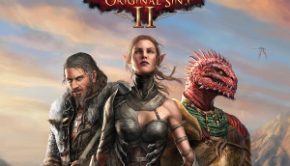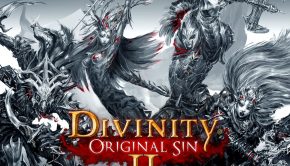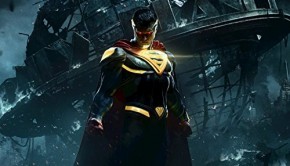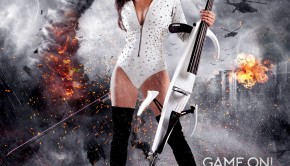Borislav Slavov & Tilman Sillescu Interview: The Making of Crysis 2’s Soundtrack
The recently released first-person shooter Crysis 2 depicts a war between human supersoldiers and alien invaders in a post-apocalyptic New York City. Crytek’s Borislav Slavov and Dynamedion’s Tilman Sillescu pioneered a hybridised full orchestral score for the title to complement the ambitious graphics and gameplay.
In preparation for the physical soundtrack release on April 24, Slavov and Sillescu come together here to discuss the making of Crysis 2‘s score. They reflect how they were deeply inspired by the game’s races, settings, and action while developing the musical approach. In addition, they discuss the recording sessions in Hungary, the game’s interactive music system, and their collaborations with cinematic legend Hans Zimmer.
Interview Credits
Interview Subject: Borislav Slavov, Tilman Sillescu
Interviewer: Chris Greening
Editor: Chris Greening
Coordination: Chris Greening, Martin Berger
Interview Content
Chris: Borislav Slavov and Tilman Sillescu, many thanks for taking the time to talk to us today about the score for Crysis 2.
Borislav Slavov: Hi Chris and thank you for inviting us to this interview.
Tilman Sillescu: Hi Chris, it is our pleasure.

Chris: Crysis 2 was described as an innovative and superlative title throughout its marketing campaign and apparently hasn’t disappointed. How far do you think the music supports this ambitious title? With the producing stating that Crysis 2 offers ‘the best graphics you’ve ever seen’, is the same also true for the music?
Borislav Slavov: Well, this is an excellent question Chris, yet I think that it should primarily be adddressed to the gamers. What I can say is that we felt greatly inspired by the game visuals and story and we did our best to express these emotions through the score. I believe that the listeners and gamers can be the true judges as to whether we succeeded and to what extent.
Tilman Sillescu: It is always difficult when it comes to music: it has so much to do with personal taste and individual emotions. What we can say is that we set the production value at the highest possible level, with more than 160 minutes of live orchestra recording with the fantastic Orchestra in Budapest, mixed and engineered at Tomtom Studios, and mastered in a three day session at the renowned Masterlab studios in Berlin. We really hope that our efforts were successful, but as Borislav said, the fans have to judge upon that…
Chris: The premise of Crysis 2 is a conflict between armoured soldiers and invading aliens in a post-apocalyptic New York City. What thematic and stylistic elements did you use portray the nature of the humans and aliens on this score?
Borislav Slavov: In the game there are three distinct factions: Marines, Cell-Ops (Crynet), and Aliens.
Being the invaders, the Aliens are the wearers of the dark, merciless, alien nature, coming to “clean” the earth of the human race. They are a high-tech, extremely well organized race, with effective military system, which also has a division of little soldiers (called Ticks) whose only goal is to follow the brute military forces and clean the freshly killed human bodies in an extremely effective way and thus reduce the negative environmental effect to zero. In short, the words that identified the music for the aliens were ‘merciless’, ‘high-tech’, yet ‘horrifying in a primal way’.
The Marines were the good guys, so they got the classical heroic military approach. And, in my opinion, the Cell-ops were a bit more challenging to portrait given they are quite controversial stereotypes. They are human beings against whom you have to fight, while the desitiny of all humanity is at stake. The music supporting these characters had to bring a high-tech hostile and aggressive mark, combined with a vibe of sadness reminding you of the fact that you are shooting at your own kind.
Chris: In contrast to the original Crysis, Crysis 2 is set in more of an urban jungle than a tropical jungle. Do you feel this caused a significant shift in the musical direction? Considering these factors was Inon Zur’s score for the original in any way influential for you or did you mostly pursue a distinct direction?
Borislav Slavov: The complete change of the setting defined a new start for the score with a completely fresh approach and themes. As you know, the first part took place on a tropical islands, while Crysis 2 is based in the urban jungle of New York. The CEO of Crytek and leader of the project, Cevat Yerli, gave the idea for special musical logos for the key elements in the game, like the city of New York and a music emblem for the aliens.
Tilman Sillescu: The first thing that comes to my mind is that we had a more symphonic approach with the Crysis 2 soundtrack: we really wanted our music to be driven by the orchestra. And sure, we needed some really new and fresh colours for the New York setting. New York is such a huge city that we felt the need to support this new setting with a strong orchestral theme. The fact, in the game’s setting, the city is totally devastated already inspired us to use some subtle colours as a kind of hints of its past. When you explore the city, you will hear sometimes shades of ethnic instruments like a lonely duduk, sometimes a jazz trumpet or a rock guitar fades in and out again; just like musical echoes which remind the player of the colourful and multi-ethnic city life that once existed there.

Chris: The score for Crysis 2 hybridises orchestral performances with electronic sampling throughout. Could you describe how you combined these components to produce a robust and cutting-edge score? What were the compositional and technical challenges involved?
Borislav Slavov: We went for a mixed approach due to two main reasons. First, we wanted to achive a high quality cinematic orchestral score. Second, the setting of the game is in the future and the factions use advanced technology to augment their military forces. After the score was done with professional samples, we recorded the tracks with live orchestra. Some of the tracks — mainly cinematics and heavy orchestral compositions — were recorded with full orchestral ensemble. Most of the in-game cues were recorded section by section (brass, strings etc.). Thus, we secured the freedom to make different variations of the final versions, where we mixed the orchestral recordings with electronics and programmed percussions.
Tilman Sillescu: Borislav and I agreed from the very first moment that we both wanted to let the orchestra dominate our compositions. We didn’t want to rely on the futuristic atmosphere by using synthetic pads or something like that. We wanted to reflect the full emotional scale that the story was offering, which we thought could be best achieved with real instruments played by real musicians. We wanted to have a coherent orchestral soundtrack with strong motifs and themes that are well structured throughout the score. But surely we didn’t forget the futuristic setting, so we used some interesting electronic colors and fresh sounds. For the aliens especially, I think we found some unexpected and weird tones that give the player an uncomfortable feeling whenever in contact with them.
Chris: Borislav Slavov, Crysis 2 is your first full orchestral score to my knowledge. What was it like to work with an orchestra for the first time? What did it allow you to offer in your compositions that you couldn’t express on the mostly sampled WorldShift.
Borislav Slavov: You’re right Chris — Crysis 2 was indeed the first time I attended live orchestral recordings. It was a real luck I did it with Tilman by my side, who is a real veteran in the field and showed me how to organize the things in the best possible way. I am also very grateful to our orchestrator Georgi Andreev, who did the orchestrations for the live orchestra recordings brilliantly. I think that nothing compares to the sound of a live orchestra. Many things can be expressed with the professional libraries of today, yet the live articulations and passion of the musicians add a soul to the music.
Chris: Tilman Sillescu, you have been involved in numerous orchestral score productions through Dynamedion. How did experiences help and influence you during the recording sessions in Hungary? Were you closely involved with these sessions and did they proceed smoothly?
Tilman Sillescu: Well, with Dynamedion, we did many orchestra sessions over recent years, so I think I was kind of prepared. However, the Crysis 2 session was a new experience for me, as we never recorded such a huge amount of music before. I was asked by Campell Askew, Crytek’s Senior Audio Director, to help a little bit with the organisation of the sessions. As a result, I contacted the guys at Tomtom Studios at an early stage, to organize things like how our scores should be delivered, which kind of clicktracks we should use, which exact size of the orchestral ensemble would be optimal for the score, etc.
On the Dynamedion side, we worked together with our orchestrator David Christiansen, who is a very experienced and well-organized guy. At the recording session, we formed a great team that worked closely together. And we all became the biggest fans of conductor Peter Pejtsik, who did a fantastic job with the talented musicians of the Budapest Orchestra. In the evenings, we explored beautiful Budapest, drinking red wine and enjoying the city life. It really was an unforgettable experience for us all, I think.

Chris: It has been widely publicised that Hans Zimmer composed the main themes of Crysis 2. What do you think the composer brought to the score with gigantic wailing themes such as “Insertion”? Are you pleased that the composer took a really unique approach with these tracks?
Borislav Slavov: Right before we went for the orchestral recordings, we were pleasantly surprised to learn that the legendary Hans Zimmer will join the team to deliver the main themes for the game. We felt deeply inspired by his contribution and he gave a strong cinematic frame with tracks like “Insertion” and “Epilogue”. Besides the fact, of course, that we collaborated with such a legend as Hans Zimmer emotionally charged us. I believe the motivation of the team was greatly increased in the last phases of the project as a result.
Tilman Sillescu: I was really excited when the news came in that the famous Hans Zimmer would join the team. At this time, we had already composed most of the in game soundtrack, so I think it was a kind of new experience for him as well: he had to contribute the main themes for a soundtrack that was almost finished, composed by some guys he probably never heard of! I have been told that he listened to every single track that we had composed so far — almost two hours of music — before he started his work. We are really happy with his themes; they add a new color to our music without being incoherent and I am sure he gave the soundtrack a kind of Hollywood boost.
Chris: Despite his incredible achievements, many feel that the scores produced by Hans Zimmer and his company are promoting the homogenisation of cinematic music. Where do you both stand on this debate? Is the composer an asset or threat to video games, or does it all depend on the producers?
Borislav Slavov: Everything is in the hands of the producers, I think. Hans Zimmer has proven several times that he is capable of fundamental surprises like the scores for The Dark Knight and Sherlock Holmes in the last couple of years. Scores like these usualy introduce a new ‘fashion’ in the cinematic music that some directors prefer to follow. So, it all depends on what your goals are.
Tilman Sillescu: Well, in my opinion, Hans has always played a special role as a film composer in Hollywood. He is a very innovative guy who has set many new trends in Hollywood. Even if some of his company’s scores may sound a little bit similar to each other, he composed many scores with unique concepts that have been copied in many ways later. I don’t think he is to blame when so many producers ask their composers to copy his style.
Chris: There must have been various challenges associated with three people working on the Crysis 2score. How did you coordinate with each other to build a cohesive final score? Were you inspired by each other throughout, or did you receive the opportunity to express some individuality too?
Borislav Slavov: For me, the biggest challenge was the amount of music, because we wanted to keep the entire score inspired and on the highest level of production values at the same time. The final amount of interactive music material that we produced is more than five hours — believe it or not — and teaming up was actually a lucky shot for the entire Crytek music team.
I am very happy that my vision and passion were fully shared by Tilman and my team-mate in Sofia, Victor Stoyanov, and the final result was a huge and varied interactive score. We collaborated through the Internet every single day and this is how some of the compositions were born. Every track we composed went through a couple of iterations, each of which was a result of feedback and ideas that we shared with each other. Working together was inspiring and entertaining at the same time.

Tilman Sillescu: By the way, even more than three composers were involved in this soundtrack. As Borislav mentioned, he was working together with Victor Stoyanov. On the Dynamedion side, my colleagues Marc Rosenberger and Alex Pfeffer were additional music composers of our soundtrack. If you look at the full credits on the soundtrack album, you will probably wonder how many people were involved altogether. But as Borislav said, the teamwork went very well.
Campbell Askew, the guy who brought our team together and made it all possible, gave us total artistic freedom, so we had the luck that our work was in no way dominated by external people. Campbell is the rare exemplar of a Senior Audio director who treats his composers as real artists — he never tried to give us too many guidelines. I am very grateful that he trusted our talent so much. We aligned to each other musically by having Skype meetings on a very frequently base and sharing our compositions, defining main motifs, musical logos, and style questions. I am still happily surprised when I think about how well this all went.
Chris: Focusing on some particular highlights, the score’s action themes are particularly breathtaking. Tilman Sillescu, could you elaborate on how you made tracks such as “Under Assault” and “No Escape” suitably dense and dynamic? How did you ensure they maintained listener’s attention during their considerable developments?
Tilman Sillescu: It is always difficult for me to talk about the composition process or my “concept”. Normally, the first thing I really focus on is to get into an inspired mood — I always use some tricks to dive into the game setting emotionally.
Concerning my action tracks, I had the opportunity that Borislav captured some in-game action scenes out of the game at its current stage, which I could use as inspiration. During my composition process, I was always watching these videos with the fight scenes to check if my music will be suitable. I listened to the music together with the sound effects, shooting, etc. This is very important to find the optimal density of action music: you have to listen to music and sound together, watching the pictures. I think this is the best way to be able to check if your music fits perfectly to the picture, if it is suitable with the sound and works emotionally when you play the game.
Chris: The score for Crysis 2 pushes the CryENGINE 3 engine with an interactive music system. Could you elaborate on the development of this interactive music system and how it is used during the game? What superior qualities does it offer in the audio department compared to other engines of today?
Borislav Slavov: The score was implemented with the in-house music interactive system, which is part of the CRYENGINE 3 technology. With its help the music in the game is able to interactively follow each situation and intensity level of the game play. In other words, the approach of the gamer has a direct impact on the music intensity in the game. We created ambient tacks which play when the player is moving stealthy or just explores the place without any enemy within a close distance. Every fight track in the game was composed in three different versions:
Tension – Played when the player is coming close to the enemy. The player is able to see the enemy, but the enemy has not discovered his presence yet.
Action – This version is being played when player is basically spotted and is already under fire.
Frantic – This version which is the highest level of intensity played when the player is badly wounded and the situation is quite dangerous for him.
As a result it feels like the currently playing track does not change but rather evolves following the intensity of the current situation in the game. You are ready to swear that you are listening to the same composition, yet it adapts smoothly in accordance with the activity on the screen.

Chris: While much of the score is dark and brutal, some of the cinematic themes are deep and personal. Borislav Slavov, how did you portray the human component in the score with “New York Aftermath” and others? Were you offered the resources to carefully match the music to the visuals when creating such pieces?
Borislav Slavov: The purpose of the track “New York Aftermath” was to summarize the story and to paint the aftermath, by blending dark electronic sounds with solo cello and piano, representatives of the human spirit and tragedy. It was initially meant for the menu in the game — as some might remember it from the multiplayer demo — and later on the track was divided into parts and implemented in key moments in the game. Actually, there is a special music track exclusively made and interactively implemented for every special event and cinematic in the game.
Chris: Clearly compositions such as the aforementioned are effective both in the game and on a contextual level. Are you pleased that the score is being exuberantly treated with both physical and digital soundtrack releases? How did you go about selecting and arranging material for these releases, and how did you decide what to omit?
Borislav Slavov: Well, the truth is that we had no idea that there would be two releases. We simply prepared all the tracks we considered worthy for a stand-alone listening experience and named them properly after the events and the levels of the game they have been playing in. Almost the same tracks have been used as collectibles in the game. The only significant differences between the digital release and the double CD compilation is in the mastering and the amount of tracks: In the main digital pack there are just 15 tracks, while the CD compillation will have three times more pieces and thus it will be more representative for the score.
Tilman Sillescu: When I heard that there would be a physical release, I was pleasantly surprised. The double CD really shows the full scale of our score, with all emotions and dramatic mood swings. Together with the iconic themes and the cinematic action tracks, the listener will find several more subtle and intimate compositions that show the emotional side of the Crysis 2 world.
Chris: When so much of the current industry is dominated by Japan and USA, it is fantastic that Crysis 2 reflects what game creators in Europe are capable of. As Europeans yourselves, are you proud to be involved in this production? Do you think the success of this title will yield further interesting game and score developments from Crytek?
Borislav Slavov: I am happy I had the chance to work on such a great game like Crysis 2. I hope this is just the begining of a long and fruitful relationship.
Tilman Sillescu: I think Crytek has a well-deserved special position as a European game developer in the international gaming industry. And yes, I think we are all a little bit proud of being part of this great production that attracts so much attention worldwide. I am definitely looking forward to working together again with this team, especially with Borislav — we both had so much fun working together and this definitively has to be continued.

Chris: Many thanks for your time today, Tilman Sillescu and Borislav Slavov. Is there anything else you would like to say about the Crysis 2 soundtrack to fans around the world?
Borislav Slavov: Thank you, Chris! I hope the people will enjoy the full score when released on CD and I also hope they will feel the emotions we went through while scoring this gorgeous game. Cheers!
Tilman Sillescu: Thank you, Chris. Nothing to add from my side — I think we pretty much covered it all.
Posted on April 18, 2011 by Chris Greening. Last modified on March 1, 2014.














